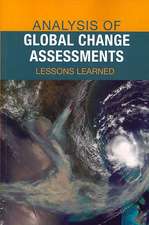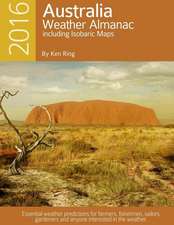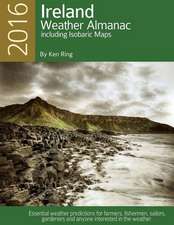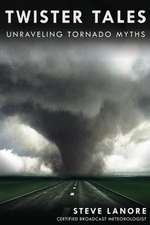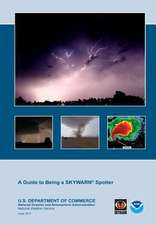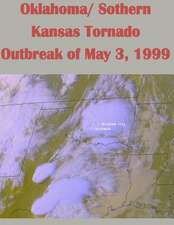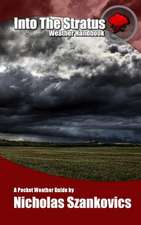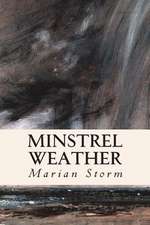Weather: A Concise Introduction
Autor Gregory J. Hakim, Jérôme Patouxen Limba Engleză Paperback – 27 dec 2017
| Toate formatele și edițiile | Preț | Express |
|---|---|---|
| Paperback (2) | 482.71 lei 3-5 săpt. | |
| Cambridge University Press – 27 oct 2021 | 482.71 lei 3-5 săpt. | |
| Cambridge University Press – 27 dec 2017 | 565.77 lei 38-44 zile | |
| Hardback (1) | 750.86 lei 3-5 săpt. | |
| Cambridge University Press – 27 oct 2021 | 750.86 lei 3-5 săpt. |
Preț: 565.77 lei
Preț vechi: 698.48 lei
-19% Nou
Puncte Express: 849
Preț estimativ în valută:
108.28€ • 112.08$ • 91.52£
108.28€ • 112.08$ • 91.52£
Carte tipărită la comandă
Livrare economică 01-07 martie
Preluare comenzi: 021 569.72.76
Specificații
ISBN-13: 9781108404655
ISBN-10: 1108404650
Pagini: 350
Ilustrații: 1 b/w illus. 476 colour illus. 7 tables
Dimensiuni: 220 x 280 x 10 mm
Greutate: 0.78 kg
Editura: Cambridge University Press
Colecția Cambridge University Press
Locul publicării:Cambridge, United Kingdom
ISBN-10: 1108404650
Pagini: 350
Ilustrații: 1 b/w illus. 476 colour illus. 7 tables
Dimensiuni: 220 x 280 x 10 mm
Greutate: 0.78 kg
Editura: Cambridge University Press
Colecția Cambridge University Press
Locul publicării:Cambridge, United Kingdom
Cuprins
Contents; Preface; Introduction; 1. Weather variables; 2. Spatial representations of weather data; 3. Our atmosphere: origin, composition, and structure; 4. Heat and energy transfer; 5. Water; 6. Cloud formation; 7. Precipitation; 8. Wind; 9. Global wind systems; 10. Air masses, fronts, and midlatitude cyclones; 11. Thunderstorms and tornadoes; 12. Tropical cyclones; 13. Weather forecasting; 14. Air pollution; 15. Climate change and weather; Glossary; References; Credits; Index.
Recenzii
'The second edition builds on the strong foundation established by Hakim and Patoux in the first edition. This text is an excellent choice for a non-science majors class or even a first meteorology class for Earth System Science majors. The expanded Appendices and Advanced Topics Boxes allow the instructor to tailor the presentation to the class and provide the curious student with additional enrichment. Clear end of chapter summaries and the new review questions provide a level of engagement for students of many levels. The chapter-spanning case study is an excellent pedagogical tool that ties together many of the concepts presented in the text.' Professor Richard W. Dixon, Texas State University
'This textbook on atmospheric sciences is a great introduction for students without strong backgrounds in mathematics and physics. It explains a wealth of weather phenomena in concise, simple, easy to follow steps starting from first principles.' Professor Chuixiang Yi, Queens College
'This second edition is a valuable refresh of an excellent introductory undergraduate text on atmospheric science. The book manages to explain complex topics in an engaging and accessible manner, including equations (with clear worked examples) where appropriate. The extensive real world examples, including new visual analysis exercises, are a real strength. I am sure this will remain a popular text with students and instructors alike.' Professor Andrew Ross, University of Leeds
'The text has a highly logical topical layout, beginning with basic weather variables then extending into more complex processes to facilitate student comprehension. All pertinent topics are included relative to an introductory weather text but the topics extend from the basic. I especially like the chapter on forecasting as most textbooks peripherally address the topic. The language, detail, explanations, level of information, figures, pictures, and end of chapter materials are all of high quality. Overall, a great textbook!' Professor Anthony J. Vega, Clarion University
'This book offers a well-balanced combination of accessibility and rigor in its coverage of weather and climate science. The text is compelling, the illustrations are clear and helpful, and the chapters succinctly cover a great breadth of material in a way that is intuitive but also quantitative. The 2nd edition's new material adds to this breadth with some more advanced concepts, additional important and timely topics, and a bit of historical perspective. Overall, this book provides a wonderful overview of weather and climate science for beginners, and serves as a great resource for introductory and general university courses.' Professor Juan Lora, Yale University
'This textbook on atmospheric sciences is a great introduction for students without strong backgrounds in mathematics and physics. It explains a wealth of weather phenomena in concise, simple, easy to follow steps starting from first principles.' Professor Chuixiang Yi, Queens College
'This second edition is a valuable refresh of an excellent introductory undergraduate text on atmospheric science. The book manages to explain complex topics in an engaging and accessible manner, including equations (with clear worked examples) where appropriate. The extensive real world examples, including new visual analysis exercises, are a real strength. I am sure this will remain a popular text with students and instructors alike.' Professor Andrew Ross, University of Leeds
'The text has a highly logical topical layout, beginning with basic weather variables then extending into more complex processes to facilitate student comprehension. All pertinent topics are included relative to an introductory weather text but the topics extend from the basic. I especially like the chapter on forecasting as most textbooks peripherally address the topic. The language, detail, explanations, level of information, figures, pictures, and end of chapter materials are all of high quality. Overall, a great textbook!' Professor Anthony J. Vega, Clarion University
'This book offers a well-balanced combination of accessibility and rigor in its coverage of weather and climate science. The text is compelling, the illustrations are clear and helpful, and the chapters succinctly cover a great breadth of material in a way that is intuitive but also quantitative. The 2nd edition's new material adds to this breadth with some more advanced concepts, additional important and timely topics, and a bit of historical perspective. Overall, this book provides a wonderful overview of weather and climate science for beginners, and serves as a great resource for introductory and general university courses.' Professor Juan Lora, Yale University

